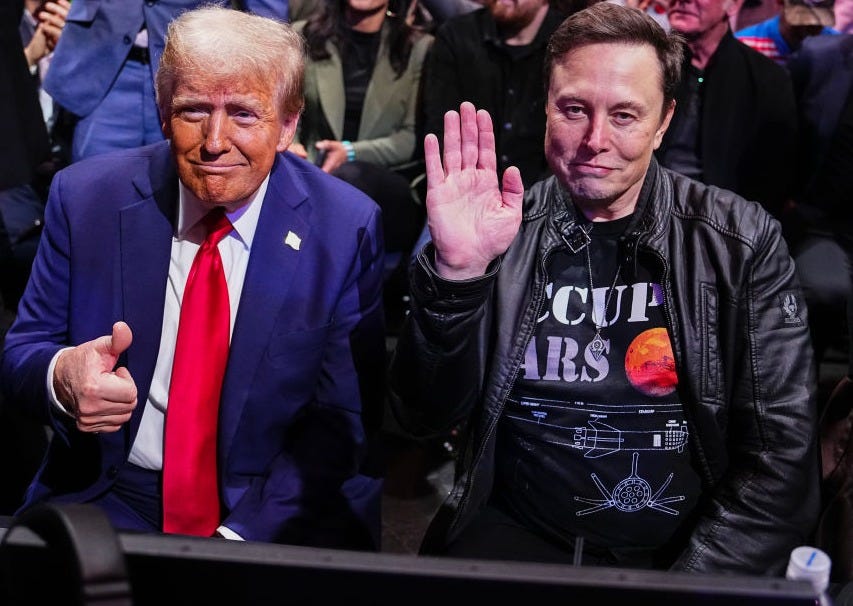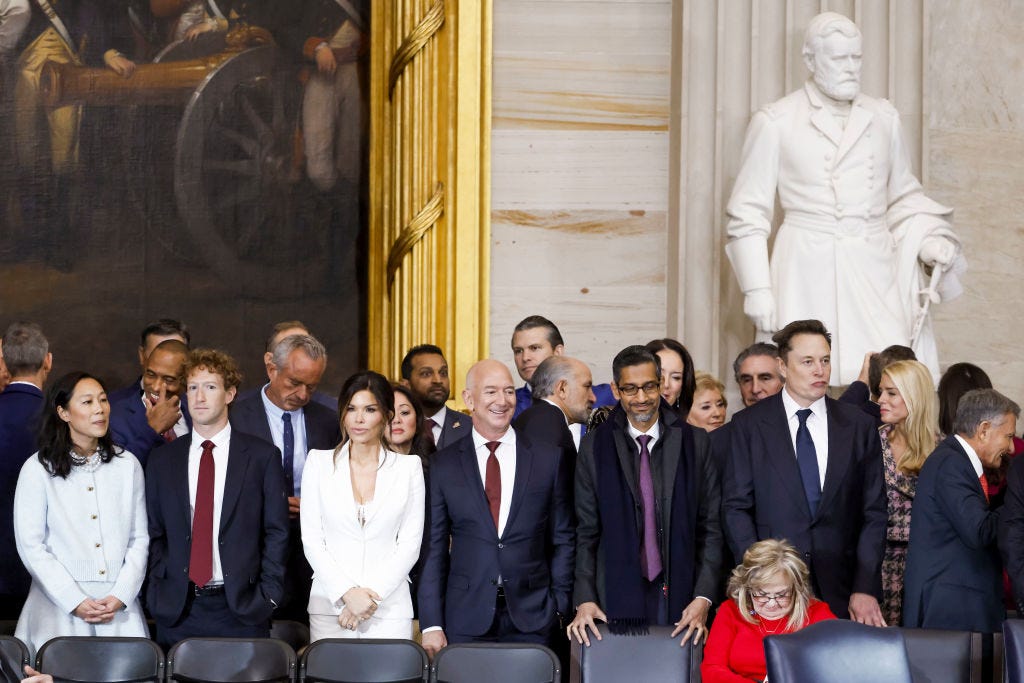The Internet Made Donald Trump
Liberal democracies must fight back against social media, or perish.

The lesson of Donald Trump’s second inauguration is that he is an abomination – but not, as was once widely believed, an aberration. Trump’s electoral influence is enduring, and he is not alone. All over the world, liberal democracies are under assault, with the far right on the march and reactionary demagogues – miniature Trumps – winning elections. It’s as if a dangerous wind is blowing everywhere at once. But why? What has changed, so recently and universally?
Belatedly, Joe Biden seemed to understand. In his farewell speech last week, Biden issued a sharp warning: “Americans are being buried under an avalanche of misinformation and disinformation enabling the abuse of power.”
He continued: “The free press is crumbling. Editors are disappearing. Social media is giving up on fact-checking. The truth is smothered by lies told for power and for profit. We must hold the social platforms accountable to protect our children, our families, and our very democracy from the abuse of power.” Explicitly referring to President Dwight D. Eisenhower's warning nearly 65 years ago about a "military-industrial complex," Biden pointed to a "tech-industrial complex" that threatened the nation.
Biden’s language might sound alarmist to some. It may seem absurd to treat Facebook, TikTok, Twitter, and YouTube as an existential threat to democratic institutions. But there’s a reason the executives of Twitter, Facebook, Instagram, and TikTok all got prime seats at Trump's inauguration. These apps, and the digital information economy they dominate, are the true secret of Trump’s power and influence. They are the force driving modern society headlong into chaos.

The Poison Killing Democracy
In the past two decades, humanity has created a massive, worldwide digital infrastructure for sharing ideas and information. It has crept into every corner of our lives, and most of us are exposed to it for many hours a day. It’s always been true that politics and markets were dominated by whichever ideas spread widest and furthest. But the internet, we're learning, privileges some ideas over others. Conspiracy theory, demagoguery, bigotry, lies, and hysteria all thrive online. And like some kind of deadly virus adapting to a new host, a new kind of political movement has evolved to take advantage of the modern information ecosystem: far-right populism.
This new political virus has spread across the planet, seemingly inexorably. It has pushed global politics in a bizarre, resentful direction and threatened to collapse governing institutions that have functioned in relative peace and stability for many years. Country after country has produced clownish national leaders who seem to simultaneously function as internet memes and extremist politicians, like Boris Johnson and Nigel Farage in the UK, Javier Milei in Argentina, and Jair Bolsonaro in Brazil. In European countries, far-right parties like France’s National Rally and Germany’s AfD have slowly climbed in popularity over years, despite repeated scandals and unpopular extremist agendas. And the trend is again peaking in the United States, with the second election of a man whose basic incoherency and unfitness once made him inconceivable as any sort of political leader.
The true villains of modern history may be the social media overlords – Elon Musk and Mark Zuckerberg, above all – who have stripped away any fetters on far-right lies and demagoguery.
For a while, it was hard to tell why politics had simultaneously jumped off the rails in so many different places. But with the passage of time, many suspected culprits in extremism’s rise have been exonerated. The economic shocks of the global financial crisis were a generation ago. Demagogues were already ascendant before the COVID pandemic, and before post-COVID inflation. Powerful right-wing propaganda channels in the United States, like Fox News, might play a role but can hardly explain an international trend. And while the world has faced challenges, it’s undergone nothing nearly as wrenching as the economic depression or world war that preceded the last far-right surge a century ago. Nonetheless, a suspiciously similar brand of far-right grievance has continued to advance, across linguistic and cultural barriers, in places as different as Brazil, India, South Korea, and the United States.
Unlike other economic and social dislocations, which are bounded in time and place, the evolution of modern media, and the rapid migration of the public’s attention to the internet, have been universal, continuous, and ongoing across virtually the entire globe. It’s time to take seriously the possibility that it’s our new digital media system that’s the fundamental cause of it all – the poison that’s killing democracy. The true villains of modern history may be the social media overlords – Elon Musk and Mark Zuckerberg, above all – who have stripped away any fetters on far-right lies and demagoguery.
A Contest for Liars
The internet represents a dramatic departure from the media ecosystems of the past, more than is commonly acknowledged. For most of the 20th century, anyone who wanted to learn about the world outside his or her immediate surroundings had to rely heavily on institutional media outlets. Although imperfect, sources like TV, radio, magazines, and newspapers typically incorporated some kind of editorial process, usually including fact-checking. Media institutions were expensive to operate at a large scale and had to worry about protecting their public reputations. The majority of information reaching the public mind passed through one of these channels.
As a result, ideas that circulated among the public bore some passing resemblance to reality. If you wanted to learn about things like the president, an upcoming election, some distant country, or the state of the economy, you were forced – through lack of options as much as anything else – to rely on a source that was carefully compiled, fact-checked, and under the conscious editorial control of professional journalists.
Today, people spend more time-consuming media than ever before. We are surrounded by screens: at home, at work, and in our pockets. The defining feature of modern life is the penetration of media into almost every waking minute. The average American spends something like six hours on the internet each day, with almost half of those dedicated to social media. For comparison, that's far more time than the average three hours a day spent watching TV. In many other nations, time spent online is similar or even higher. We are surrounded by internet media, and much of our communication with each other and the outside world passes through it.
But online media doesn't work like traditional media. Online, there are few fact-checkers and little editorial processes. Rather than relying on staid institutions like the New York Times or ABC News, ideas and information can come from anywhere. In the past, a media outlet needed significant capital and multiple employees to reach even a local audience. Today, anyone who can afford a phone and an internet connection has a potential audience that includes, quite literally, the majority of America.
This may sound like a welcome, democratizing change. But consider which ideas spread fastest online: not the ones that are most accurate, but the ones that receive the most attention. Especially on social media, feeds are dominated by whichever idea, claim, or meme is going viral at a given moment. This is almost tautologically true, in fact: since social media lacks any traditional "front page" under the conscious control of an editor, an individual's feed is disproportionately populated by the most popular posts and subjects. The more viral it is, the more people will see it; the more people will see it, the more viral it is.
Over time, we have learned perhaps the key principle of internet virality: angry people click more. Audiences will frenetically consume information and rhetoric that provokes strong emotions, especially negative emotions. People feel compelled to share material that frightens them, enrages them, or makes them feel resentful. They particularly share material that validates their own beliefs, biases, and prejudices. Very often, in practice, this means ideas that capitalize on existing social resentments and frictions – searing claims about immigrants, nonwhite people, or stigmatized minorities are a reliable hit. Conspiracy theories also do well, exploiting fear and distrust of institutions to evoke a poisonous rage.
This has turned large swaths of the internet into little more than a contest for liars.
After all, online, who cares if claims are true or not, as long as people share them? The social and financial rewards of online attention are barely reduced when the underlying claim is false. Indeed, truth-tellers are at a massive disadvantage on the internet since they're forced to compete with wild, hysterical, or completely manufactured material that has been engineered specifically to attract notice and be shared. Many people have persisted in publishing true facts anyway – but they often sink out of sight, occluded by the more viral claims of skilled fabulists.
A Mass Hallucination Factory
The power of truly viral ideas is almost beyond imagination.



